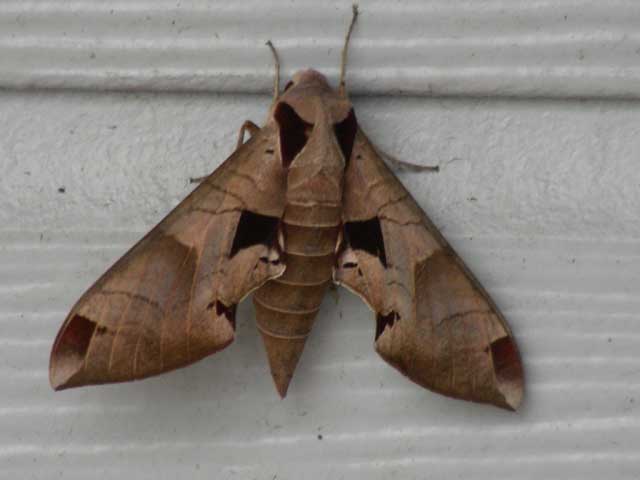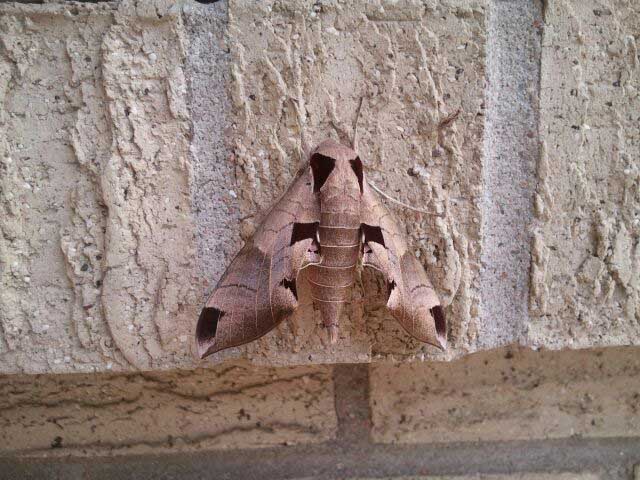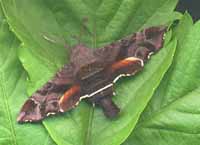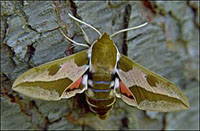Jefferson County, Colorado
Sphingidae

Eumorpha achemon, Lakewood, Jefferson County, Colorado,
July 2011, courtesy of Gail Youmans.
|
|
Inspired by and dedicated to Gail Youmans, July 2011; August 13, 2011 Updated as per James P. Tuttle's The Hawk Moths of North America, August 13, 2011 Updated as per BAMONA, August 13, 2011 Updated as per personal communication with Sue Hiegel (Eumorpha achemon, Littleton, June 27, 2012); June 30, 2012 |

This site has been created by
Bill Oehlke at oehlkew@islandtelecom.com
Comments, suggestions and/or additional information/sightings are welcomed by Bill.
This page is inspired by and dedicated to
Gail Youmans who sends the image of Eumorpha achemon
at top of the page.
Gail writes, August 10, 2011, "Does seeing this moth mean anything for the winter moths? Will it be an early winter etc?"
I reply, "Hi Gail,
"I request permission to post your image of Eumorpha achemon, the Achemon Sphinx, to a Jefferson County thumbnail page that I will create??
"This is typical flight time for that species in Colorado. It does not indicate anything other than that you have breeding populations of
Eumorpha achemon in your area."
Many thanks also to Sue Hiegel who sends this picture of Eumorpha achemon from Littleton, June 29, 2012.

Eumorpha achemon, Littleton, Jefferson County, Colorado,
June 27, 2012, courtesy of Sue Hiegel.
A "WO" after the species name indicates that I (William Oehlke) expect that this moth is present or might be present, although unreported. A "BAMONA" indicates the moth is confirmed on USGS site (now BAMONA).
Please help me develop this list with improved, documented accuracy by sending sightings (species, date, location), preferably with an electronic image, via email to Bill Oehlke.
Please also submit sightings to BAMONA, an excellent online resource, via link to left or top of page.
Sphinginae subfamily
Ceratomia catalpae BAMONA, as a stray or misidentified.
Sphinx perelegans BAMONA, probably confused with Sphinx vashti. I doubt Sphinx perelegans is present anywhere in Colorado.
Smerinthini Tribe:
Macroglossinae subfamilyDilophonotini tribe:
Philampelini tribe:
Eumorpha achemon, Lakewood, July 2011, courtesy of Gail Youmans. |
 | Amphion floridensis BAMONA, the Nessus SphinixThis day flier is widely distributed. If you have Virginia Creeper, you probably have the Nessus Sphinx. Two bright, distinct, narrow yellow bands are often visible on the abdomen. |
 |
Darapsa myron
WO, the Virginia Creeper Sphinx or the
Grapevine Sphinx |
 | Euproserpinus wiesti WO, Prairie Sphinx or Wiest's Primrose Sphinx: Black body with white band on abdomen. FW upperside gray-brown; median area has black lines and gray band; underside white with black o. m.. Hw upperside yellowish white with narrow black o. m., black at base. |
 |
Hyles euphorbiae
WO, the Spurge Hawk Moth
|
 |
Hyles gallii
WO, the Bedstraw Hawk Moth
or Gallium Sphinx |
 |
Hyles lineata
WO,
the White-lined Sphinx |
 | Proserpinus juanita BAMONA, the Juanita SphinxThe upperside of the forewing is pale gray-green with a deep green-brown median area and a white dash at the wing tip. |
Enjoy some of nature's wonderments, giant silk moth cocoons. These cocoons are for sale winter and fall. Beautiful Saturniidae moths will emerge the following spring and summer. Read Actias luna rearing article. Additional online help available.
Eggs of many North American species are offered during the spring and summer. Occasionally summer Actias luna and summer Antheraea polyphemus cocoons are available. Shipping to US destinations is done from with in the US.
Use your browser "Back" button to return to the previous page.
This page is brought to you by Bill Oehlke and the WLSS. Pages are on space rented from Bizland. If you would like to become a "Patron of the Sphingidae Site", contact Bill.
Please send sightings/images to Bill. I will do my best to respond to requests for identification help.
 Show appreciation for this site by clicking on flashing butterfly to the left. The link will take you to a page with links to many insect sites. |